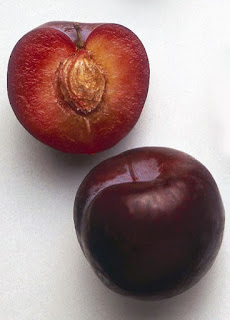Had a few minor setbacks last weekend. 1) all the apple trees show signs of multiple types of disease, the red and golden delicious ones being the worst. They have white thick spider web looking material between the crevices of the branches and have spots on all the leaves. Some are even curling up. 2) Upon trying to water the trees with the water hose and tugging a little too hard, I broke the metal pole off of the water spout. I found out just how good my water pressure was b/c I had a geyser about 30 feet tall. Fortunately it's been raining non-stop since then, so it's given me a little time to fix it. So sad.
On the bright side, the blueberries are doing GREAT. The pears looks great too (no signs of disease) but no fruit yet. The peaches show the occassional hole, a few yellow leafs here and there, and some oozing sap in the fruit (i'm guess some bugs are drilling holes), but have a good bit of fruit that looks good. The pecans are so-so. Time will tell.
Started some blueberry and blackberry seeds about 2 weeks ago. They take 1 month to sprout. So long!
JF190 Jumbo Thornless Blackberry Rubus fruticosus These plants
provide abundant amounts of delicious sweet fruit in the summer, and the
thornless stems make them very easy to harvest.
One of the most important
advances in the blackberry industry was the development of thorn-less varieties,
which need to be trellised, this is not often noted when you buy plants or seeds
but it is necessary. We grow ours along side a fence for support. New shoots are
tied to the wires with soft string as they grow. Pruning is fairly simple since
you keep only 4 to 8 canes per plant. All weak canes and suckers are removed.
Hardiness zones: 3-9 Pre-stratified seeds need to be planted immediately
upon receipt.
FDR97 Highbush Blueberry Vaccinium corymbosumA deciduous
medium to large multi-stemmed sized shrub that can grow to 10 feet tall, but
normally in the 7-9 feet range. The flowers bloom from May to June. The blooms
are typically numerous and somewhat showy. The highbush blueberry fruits are
small (1/3 inch), dark blue and covered with a white film. The berry ripens in
mid to late summer. The fruits are sweet and delicious. For this tree the ideal
soil is moist, high in organic matter and well-drained. It prefers an acidic
soil (4.5 to 5.5). The blueberry tree likes to have mulch around the roots and
full sun to partial shade. More sun translates into more into more blooms, more
fruit and enhanced fall foliage color. Hardiness zones: 3-9 Pre-stratified seeds
need to be planted immediately upon receipt.
D8509 Kiwi Fruit Actindia chinensisCold hardy to zone 4. Kiwis
are vigorous vines. They cannot support their own weight and will spread up to
30 feet. They require strong support such as trellis, arbor, or fence. In
nature, they grow up into trees. Training to the south side of a building is
excellent for the small planting. Kiwi vines are heavy feeders and like their
roots to be in warm soil. A mature kiwi vine can produce 200 pounds of
fruit.
Kiwis require special training and pruning to produce good crops. When
planted, the vines should be pruned back to 4 or 5 buds. From these a main stem
should be selected and staked to grow to the top of the arbor or trellis,
usually 6-7’ high. The trellis should be strong to support the heavy future
fruit loads.
Kiwis are beautiful vines. Their vigorous spring growth is a
spectacular sight. Excellent for a privacy screen, they will rapidly cover a
fence and with support will cover a wall or steep slope. Kiwis grow in a manner
similar to grapes but more rapidly. They are very high in Vitamin C. (Ten times
as much as lemons.) They are excellent for eating fresh and are a tasty addition
to salads and desserts. Ice cream, pies, jam and wine are other ways to use
kiwis.
Very compelling plant names, eh? Easy to remember too.








